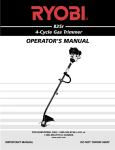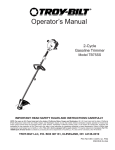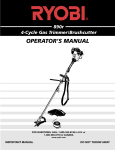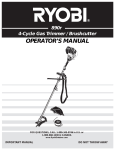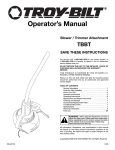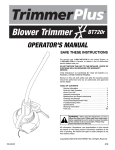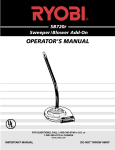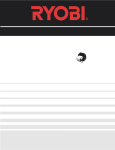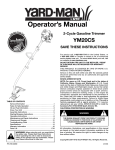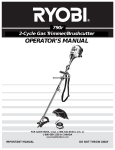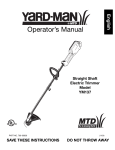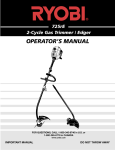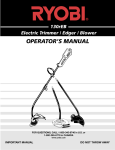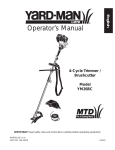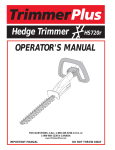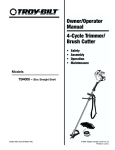Download OPERATOR`S MANUAL
Transcript
1090r 4-Cycle Gas Trimmer / Brushcutter OPERATOR’S MANUAL FOR QUESTIONS, CALL 1-800-345-8746 in U.S. or 1-800-265-6778 in CANADA www.ryobi.com IMPORTANT MANUAL DO NOT THROW AWAY INTRODUCTION TABLE OF CONTENTS THANK YOU I. California Emission Regulations . . . . . . . . 3 Thank you for purchasing this quality product. This modern outdoor power tool is designed to provide many hours of useful service. You will find it to be a great labor-saving device. This operator’s manual provides you with easy-tounderstand operating instructions. Read the entire manual and follow all of the instructions to keep your new outdoor power tool in top operating condition. The other manual that came with your power tool, the parts manual, contains all of the information that you need to order parts. II. Rules for Safe Operation . . . . . . . . . . . 3-8 A. Important Safety Information . . . . . . 4-6 B. Safety and International Symbols . . . 6-7 C. Know Your Unit . . . . . . . . . . . . . . . . . . 8 PRODUCT REFERENCES, ILLUSTRATIONS AND SPECIFICATIONS All information, illustrations and specifications in this manual are based on the latest product information available at the time of printing. We reserve the right to make changes at any time without notice. Copyright © 1998 Ryobi Outdoor Products, Inc. All Rights Reserved. Bump Head™ is a trademark of Ryobi Outdoor Products. Click-Link® is a registered trademark of Ryobi Outdoor Products. SERVICE INFORMATION Service on this unit both within and after the warranty period should be performed only by an authorized and approved service dealer. Dial 1-800-345-8746 in the United States and 1-800-265-6778 in Canada to obtain the listing of the authorized service dealer nearest you. Do not return the unit to the retailer. III. Assembly Instructions . . . . . . . . . . . . 9-12 A. Adjusting the J-Handle . . . . . . . . . . . . 9 B. Installing the Harness . . . . . . . . . . . . . 9 C. Removing and Installing the Cutting Attachment Shield . . . . . . . . . 10 D. Remove the Cutting Blade and Install the Cutting Attachment . . . . . . 10 E. Removing the Cutting Attachment and Installing the Cutting Blade . . . . . 11 IV. Oil and Fuel Information . . . . . . . . . . . . . 13 V. Starting/Stopping Instructions . . . . . . . . 14 VI. Operating Instructions . . . . . . . . . . . 15-17 A. Operating Click-Link System . . . . . . . 15 B. Adjusting Trimming Line Length . . . . . 16 C. Decorative Trimming . . . . . . . . . . . . . 16 D. Edging . . . . . . . . . . . . . . . . . . . . . . . . 16 E. Using the Cutting Blade . . . . . . . . . . . 16 VII. Maintenance and Repair Instructions .17-23 A. Maintenance Schedule . . . . . . . . . . . 17 B. Line Installation . . . . . . . . . . . . . . . . . .18 C. Installing a Prewound Reel . . . . . . . . . 19 D. Air Filter Maintenance . . . . . . . . . . . . 20 E. Carburetor Adjustment . . . . . . . . . . . 21 F. Checking the Oil Level . . . . . . . . . . . . 21 G. Changing the Oil . . . . . . . . . . . . . . . . 22 H. Checking/Adjusting Valve to Rocker Arm Clearance . . . . . . . . . . . . 22 I. Replacing the Spark Plug . . . . . . . . . 23 VIII. Cleaning and Storage . . . . . . . . . . . . . . .24 A. Accessories/Replacement Parts . . . . 24 IX. Troubleshooting Chart . . . . . . . . . . . . . . 25 NOTE: PROOF OF PURCHASE WILL BE REQUIRED FOR WARRANTY SERVICE. X. Specifications . . . . . . . . . . . . . . . . . . . . 26 XI. Warranty . . . . . . . . . . . . . . . . . . . . . . 27-28 Make sure this manual is carefully read and understood before starting or operating this equipment. THIS PRODUCT IS COVERED BY ONE OR MORE OF THE US PATENTS LISTED BELOW: 5,241,932; 5,176,116; 4,779,405; 4,651,422; 4,589,742; 4,505,040; 4,463,498; 4,356,605; 4,342,235; 4,223,441; 4,369,742; 5,267,536; 5,243,937; 5,263,454; 5,293,847; 5,558,057; 5,421,292; 5,463,809; 5,564,374; 5,738,062; Des. 355,198; OTHER PATENTS PENDING. 2 CONTENTS OF CARTON This unit should consist of the following: • Model 1090r with J-Handle and 4-Tooth Cutting Blade with Cover • String Guard and Hardware • Bump Head™ String Cutting Attachment • Shoulder Harness • Locking Rod • 3.4 oz. Bottle of 4-Cycle Oil (SAE 30) • Operator's Manual and Parts Manual • Product Registration Card CALIFORNIA EMISSION REGULATIONS This unit meets the 1995 to 1998 California emissions regulations for small off-road engines. These units are identified by the label on the engine of your product. A typical identification label is shown. To ensure that your unit continues to meet these regulations, refer to the following information and instructions in this operator’s manual. California Proposition 65 Warning: WARNING THE ENGINE EXHAUST FROM THIS PRODUCT CONTAINS CHEMICALS KNOWN TO THE STATE OF CALIFORNIA TO CAUSE CANCER, BIRTH DEFECTS OR OTHER REPRODUCTIVE HARM. SPARK ARRESTOR NOTE: For users on U.S. Forest Land and in the states of California, Maine, Oregon and Washington. All U.S. Forest Land and the state of California (Public Resources Codes 4442 and 4443), Oregon and Washington require, by law that certain internal combustion engines operated on forest brush and/or grass-covered areas be equipped with a spark arrestor, maintained in effective working order, or the engine be constructed, equipped and maintained for the prevention of fire. Check with your state or local authorities for regulations pertaining to these requirements. Failure to follow these requirements could subject you to liability or a fine. This unit is factory equipped with a spark arrestor. If it requires replacement, ask your LOCAL SERVICE dealer to install the Accessory Part #182153 Spark Arrestor Kit. FOR QUESTIONS, CALL 1-800-345-8746 IN U.S. OR 1-800-265-6778 in CANADA RULES FOR SAFE OPERATION The purpose of safety symbols is to attract your attention to possible dangers. The safety symbols, and their explanations, deserve your careful attention and understanding. The safety warnings do not by themselves eliminate any danger. The instructions or warnings they give are not substitutes for proper accident prevention measures. SYMBOL DANGER: Failure to obey a safety warning will result in serious injury to yourself or to others. Always follow the safety precautions to reduce the risk of fire, electric shock, and personal injury. WARNING: Failure to obey a safety warning can result in serious injury to yourself or to others. MEANING SAFETY ALERT SYMBOL: Indicates danger, warning, or caution. Special attention is required in order to avoid serious personal injury. May be used in conjunction with other symbols or pictographs. CAUTION: Failure to obey a safety warning may result in property damage or personal injury to yourself or to others. NOTE: Advises you of information or instructions vital to the operation or maintenance of the equipment. 3 RULES FOR SAFE OPERATION • IMPORTANT SAFETY INFORMATION • READ ALL INSTRUCTIONS BEFORE OPERATING • Read the instructions carefully. Be familiar with the controls and proper use of the unit. • Do not operate this unit when tired, ill, or under the influence of alcohol, drugs, or medication. • Children and teens under the age of 15 must not use the unit, except for teens guided by an adult. • Inspect the unit before use. Replace damaged parts. Check for fuel leaks. Make sure all fasteners are in place and secure. Replace cutting attachment parts that are cracked, chipped, or damaged in any way. Make sure the cutting attachment is properly installed and securely fastened. Be sure the cutting attachment shield is properly attached, and positioned as recommended. Failure to so can result in personal injury to the operator and bystanders, as well as damage to the unit • Use only 0.095 in (2.41 mm) diameter genuine Ryobi replacement line. Never use metal-reinforced line, wire, or rope, etc.. These can break off and become a dangerous projectile. • Be aware of the risk of injury to the head, hands and feet. • Clear the area to be cut before each use. Remove all objects such as rocks, broken glass, nails, wire, or string which can be thrown or become entangled in the cutting attachment. Clear the area of children, bystanders, and pets. At a minimum, keep all children, bystanders and pets outside a 50 ft. (15 m.) radius; there still may be a risk to bystanders from thrown objects. Bystanders should be encouraged to wear eye protection. If you are approached, stop the engine and cutting attachment immediately. • Squeeze the throttle control and check that it returns automatically to the neutral position. Make all adjustments or repairs before using unit. SAFETY WARNINGS FOR GAS TRIMMERS WARNING: Gasoline is highly flammable, and its vapors can explode if ignited. Take the following precautions: 4 • Store fuel only in containers specifically designed and approved for the storage of such materials. • Avoid creating a source of ignition for spilled fuel. Do not start the engine until fuel vapors dissipate. • Always stop the engine and allow it to cool before filling the fuel tank. Never remove the cap of the fuel tank, or add fuel, when the engine is hot. Never operate the unit without the fuel cap securely in place. Loosen the fuel tank cap slowly to relieve any pressure in the tank. • Mix and add fuel in a clean, well-ventilated area outdoors where there are no sparks or flames. Slowly remove the fuel cap only after stopping engine. Do not smoke while fueling or mixing fuel. Wipe up any spilled fuel from the unit immediately. • Move the unit at least 30 ft. (9.1 m) from the fueling source and site before starting the engine. Do not smoke, keep sparks and open flames from the area while adding fuel or operating the unit. WHILE OPERATING • Never start or run the unit inside a closed room or building. Breathing exhaust fumes can kill. Operate this unit only in a well ventilated area outdoors. • Wear safety glasses or goggles that are marked as meeting ANSI Z87.1-1989 standards, and ear/hearing protection when operating this unit. Wear a face or dust mask if the operation is dusty. Long sleeve shirts are recommended. • Wear heavy, long pants, boots and gloves. Do not wear loose clothing, jewelry, short pants, sandals or go barefoot. Secure hair above shoulder level. • The cutting attachment shield must always be in place while operating the unit as a trimmer. Do not operate unit without both trimming lines extended, and the proper line installed. Do not extend the trimming line beyond the length of the shield. • This unit has a clutch. The cutting attachment remains stationary when the engine is idling. If it does not, have the unit adjusted by an authorized service technician. • Adjust the J-handle to your size to provide the best grip. RULES FOR SAFE OPERATION • Be sure the cutting attachment is not in contact with anything before starting the unit. • Use the unit only in daylight or good artificial light. • Avoid accidental starting. Be in the starting position whenever pulling the starter rope. The operator and unit must be in a stable position while starting. See Starting/Stopping Instructions. • Use the right tool. Only use this tool for the purpose intended. • Do not overreach. Always keep proper footing and balance. • Always hold the unit with both hands when operating. Keep a firm grip on both the front and rear handle or grips. • Keep hands, face, and feet at a distance from all moving parts. Do not touch or try to stop the cutting attachment when it is rotating. • Do not touch the engine or muffler. These parts get extremely hot from operation. When turned off they remain hot for a short time. • Do not operate the engine faster than the speed needed to cut, trim or edge. Do not run the engine at high speed when not cutting. • Always stop the engine when cutting is delayed or when walking from one cutting location to another. • If you strike or become entangled with a foreign object, stop the engine immediately and check for damage. Do not operate before repairing damage. Do not operate the unit with loose or damaged parts. • Stop and switch the engine to off for maintenance, repair, or for changing the cutting attachment or other attachments. • Use only genuine Ryobi replacement parts when servicing this unit. These parts are available from your authorized service dealer. Do not use parts, accessories or attachments not authorized by Ryobi for this unit. Doing so could lead to serious injury to the user, or damage to the unit, and void your warranty. • Keep unit clean of vegetation and other materials. They may become lodged between the cutting attachment and shield. • To reduce fire hazard, replace faulty muffler and spark arrestor, keep the engine and muffler free from grass, leaves, excessive grease or carbon build up. WHILE OPERATING WITH CUTTING BLADE • Read and understand all safety warnings before operating this unit. • Always use the shoulder harness when using the brush blade accessory. • Keep the handle between the operator and cutting attachment or blade at all times. • NEVER cut with the cutting blade located over 30 inches (76 cm) or more above the ground level. • Blade thrust may occur when the spinning blade contacts an object that it does not immediately cut. Blade thrust can be violent enough to cause the unit and/or operator to be propelled in any direction , and possibly lose control of the unit. Blade thrust can occur without warning if the blade snags, stalls or binds. This is more likely to occur in areas where it is difficult to see the material being cut. • For operation with the brush blade, do not cut anything thicker than 1/2 inch or a violent kickback could occur. • Do not attempt to touch or stop the blade when it is rotating. • A coasting blade can cause injury while it continues to spin after the engine is stopped or the throttle trigger is released. Maintain proper control until the blade has completely stopped rotating. • Do not run the unit at high speed when not cutting. • If you strike or become entangled with a foreign object, stop the engine immediately and check for damage. Have any damage repaired before attempting further operations. Do not operate unit with a bent, cracked or dull blade. Discard blades that are bent, warped, cracked or broken. • Do not sharpen the cutting blade. Sharpening the blade can cause the blade tip to break off while in use. This can result in severe personal injury. Replace the blade. • Stop the engine IMMEDIATELY if you feel excessive vibration. Vibration is a sign of trouble. Inspect thoroughly for loose nuts, bolts or damage before continuing. Repair or replace affected parts as necessary. 5 RULES FOR SAFE OPERATION AFTER USE • Clean cutting blades with a household cleaner to remove any gum buildup. Oil the blade with machine oil to prevent rust. • Lock up and store the cutting blade in an appropriate area to protect the blade from unauthorized use or damage. OTHER SAFETY WARNINGS • Never store the unit, with fuel in the tank, inside a building where fumes may reach an open flame or spark. • Allow the engine to cool before storing or transporting. Be sure to secure the unit while transporting. • Store the unit in a locked up and dry, or high and dry place to prevent unauthorized use or damage. Keep out of the reach of children. • Never douse or squirt the unit with water or any other liquid. Keep handles dry, clean and free from debris. Clean after each use, see Cleaning and Storage instructions. • Keep these instructions. Refer to them often and use them to instruct other users. If you loan someone this unit, also loan them these instructions. SAVE THESE INSTRUCTIONS SAFETY AND INTERNATIONAL SYMBOLS This operator's manual describes safety and international symbols and pictographs that may appear on this product. Read the operator's manual for complete safety, assembly, operating and maintenance and repair information. SYMBOL MEANING • SAFETY ALERT SYMBOL Indicates danger, warning, or caution. May be used in conjunction with other symbols or pictographs. • READ OPERATOR'S MANUAL Failure to follow operating instructions and safety precautions in operator's manual can result in serious injury. Read operator's manual before starting or operating this unit. • FOR SERVICE INFORMATION, CALL: USA: 1-800-345-8746 CANADA: 1-800-265-6778 • WEAR EYE AND HEARING PROTECTION WARNING: Thrown objects and loud noise can cause severe eye injury and hearing loss. Wear eye protection meeting ANSI Z87.11989 standards and ear protection when operating this unit. • KEEP BYSTANDERS AWAY WARNING: Keep all bystanders, especially children and pets, at least 50 feet (15 m) away from the trimming area. • PRIMER BULB Push primer bulb, fully and slowly, 5 to 7 times. • UNLEADED FUEL Always use clean, fresh unleaded fuel. 6 RULES FOR SAFE OPERATION SYMBOL MEANING • INDICATES OIL Refer to operator's manual for the proper type of oil. • CHOKE CONTROL A B START position. RUN position. • THROWN OBJECTS AND ROTATING CUTTER CAN CAUSE SEVERE INJURY WARNING: Do not operate unit without string guard in place. Keep away from rotating cutter. • IGNITION SWITCH ON / START / RUN • IGNITION SWITCH OFF or STOP • HOT SURFACE WARNING Do not touch a hot muffler, gear box or cylinder. You may get burned. These parts get extremely hot from operation and remain hot for a short time after the unit is turned off. • SHARP BLADE WARNING: Sharp blade on string guard. To prevent serious injury, do not touch line cutting blade. • BRUSHCUTTERS Replace dull blade. Do not sharpen the brush blade. Sharpening the blade can cause the blade tip to break off while in use. This can result in severe personal injury. • TRIMMER/BRUSHCUTTER SAFETY WARNING: Thrown objects and rotating cutter can cause severe injury. Keep bystanders, especially children and pets, at least 50 feet (15 m) away from the cutting area. Plastic string guard must be used when using the string cutting head. 7 RULES FOR SAFE OPERATION KNOW YOUR UNIT Starter Rope Grip Primer Bulb Spark Plug Air Filter Cover Handgrip On/Off Stop Control Choke Lever Oil Fill Plug / Dipstick Fuel Cap Throttle Control Gear Housing J-Handle Blade Guard Shoulder Harness 4-Tooth Blade with Cover Click-Link Shaft Housing Line Cutting Blade Cutting Attachment Shield APPLICATION Cutting Attachment 8 Use the string head for cutting light grass and weeds. Also for decorative trimming around trees, fences, etc. Use the 4-tooth brush blade for weeds and light brush of up to 1/2 inch in diameter. Other attachments may be used with this unit. See the list of attachments on page 15. ASSEMBLY INSTRUCTIONS ADJUSTING THE J-HANDLE The J-handle is assembled on this model not in the correct position. Use the following instructions to adjust the J-handle to the correct position. 1. Loosen the four (4) mounting screws on the J-handle. 2. Slide the J-handle until the arrow/bar on the decal is flush to the edge of the clamp assembly (Fig. 1). 3. While holding the unit in the operating position (Fig. 2), adjust (rotate) the handle forward and back to a position that provides you the best grip. 4. Tighten the mounting screws. INSTALLING THE HARNESS WARNING: Always use the shoulder harness when using the cutting blade to avoid serious personal injury. 1. Push the strap through the center of the buckle. 2. Pull the strap over the cross bar and down through the slot in the buckle (Fig. 3). 3. Snap it on to the support fitting (Fig. 4). 4. Adjust length to fit the operator’s size. Pull tab to lengthen, pull strap to shorten (Fig 5). Screws Decal Fig. 3 Fig. 1 Fig. 4 Fig. 2 Fig. 5 9 ASSEMBLY INSTRUCTIONS REMOVING AND INSTALLING CUTTING ATTACHMENT SHIELD Remove the cutting attachment shield when using the unit as a brushcutter. WARNING: The cutting attachment shield should NOT be installed when operating the unit with a blade. Remove the cutting attachment shield before removing or installing the blade. Remove the cutting attachment shield from the shield mount by removing the three (3) screws with a flat blade screwdriver (Fig. 6). Store parts for future use. NOTE: To make removing or installing the cutting blade or cutting attachment easier, place the unit on the ground or on a work bench. 1. Install the cutting blade cover. Pull the cover around the blade and click the plastic lock. 2. Align the shaft bushing hole with the locking rod slot and insert the locking rod into the bushing hole (Fig. 7). Output Shaft Output Shaft Bushing Locking Rod Screws Locking Shaft Bushing Hole Rod Slot Fig. 7 3. While holding the locking rod, loosen the nut on the blade by turning it clockwise with a 5/8 inch closed-end or socket wrench (Fig. 8). String Guard Fig. 6 Install the cutting attachment shield when using the unit as a grass trimmer. WARNING: To avoid serious personal injury, the cutting attachment shield SHALL be in place at all times while operating the unit as a grass trimmer. clockwise Fig. 8 Install the cutting attachment shield on the shield mount by inserting the three (3) screws into the shield mount. Tighten securely with a flat blade screwdriver (Fig. 6). 4. Remove the nut, blade retainer, and blade. Store the nut and blade together for future use in a secure place. Store out of reach of children. REMOVE THE CUTTING BLADE AND INSTALL THE CUTTING ATTACHMENT Install the Cutting Attachment Remove the Cutting Blade WARNING: To avoid serious personal injury, always wear gloves while handling or installing the blade. 5. Align the shaft bushing hole with the locking rod slot and insert the locking rod into the shaft bushing hole. (Fig. 7). Put the blade retainer onto the output shaft. Screw the cutting attachment counterclockwise onto the output shaft. Tighten securely (Fig. 9). NOTE: The blade retainer must be installed on the output shaft for the cutting attachment to work correctly. 10 ASSEMBLY INSTRUCTIONS Cutting Attachment Cutting Attachment Blade Retainer Locking Rod Locking Rod Slot Locking Rod Fig. 10 Fig. 9 6. Remove the locking rod. 7. Install the cutting attachment shield. See Removing and Installing Cutting Attachment Shield, Pg. 10. WARNING: To avoid serious personal injury, the cutting attachment shield SHALL be in place at all times while operating the unit as a grass trimmer. Install the Cutting Blade WARNING: To avoid serious personal injury, always wear gloves while handling or installing the blade. 3. Place the cutting blade on the output shaft (Fig. 11). Nut Blade Retainer Blade Cover REMOVING THE CUTTING ATTACHMENT AND INSTALLING THE CUTTING BLADE NOTE: To make removing or installing the cutting blade or cutting attachment easier, place the unit on the ground or on a work bench. Cutting Blade Pilot Hole Output Shaft Locking Rod Remove the Cutting Attachment Shield See Removing and Installing Cutting Attachment Shield, Pg. 10. Remove the Cutting Attachment Shield Mount Fig. 11 4. Center the cutting blade on the pilot step of the output shaft bushing (Fig. 12). Output Shaft WARNING: The gear housing gets hot with use and can result in injury to the operator. When the unit is turned off it remains hot for a short time. Do not touch the gear housing until it has cooled. 1. Align the shaft bushing hole with the locking rod slot and insert the locking rod into the shaft bushing hole (Fig. 7). 2. While holding the locking rod, remove the cutting attachment by turning it clockwise off of the output shaft (Fig. 10). Store the cutting attachment for future use. Pilot Step Output Shaft Bushing Fig. 12 11 ASSEMBLY INSTRUCTIONS 5. Make sure that the cutting blade is centered on the pilot step and sitting flat against the output shaft bushing (Fig. 13). WARNING: If the cutting blade is off-center, the unit will vibrate, and the blade may fly off, which can cause serious personal injury. Pilot Step Fig. 13 6. Align the shaft bushing hole with the locking rod slot and insert the locking rod into the bushing hole (Fig. 7, Pg. 10). 7. Put the blade retainer and nut on the output shaft. Make sure that the blade is installed correctly. 8. Tighten counterclockwise against the blade while holding the locking rod (Fig. 14). • If using a torque wrench and an 5/8 inch socket tighten to; 325 - 335 in•lb, 27 - 28 ft.•lb, 37 -38 N•m. • Without a torque wrench, use a 5/8 inch closed-end or socket wrench, turning the nut until the blade retainer is snug against the shaft bushing. Make sure that the blade is installed correctly, then rotate the nut an additional 1/4-1/2 turn counterclockwise (Fig. 15). 1/4-1/2 turn Counterclockwise Fig. 15 9. Remove the locking rod from the locking rod slot. WARNING: To avoid serious personal injury or damage to the unit, do not start or operate this unit with the locking rod in the locking rod slot. 10.Remove the cutting blade cover by un-snapping the plastic lock on the cover and pulling it from the blade. Store the cover for future use. Counterclockwise Fig. 14 WARNING: Do not sharpen the cutting blade. Sharpening the blade can cause the blade tip to break off while in use. This can result in severe personal injury. Replace the blade. NOTE: A replacement cutting blade, Part # 145873 can be purchased from you local authorized dealer. 12 OIL AND FUEL INFORMATION RECOMMENDED OIL TYPE Using the proper type and weight of oil in the crankcase is extremely important. Check the oil before each use and change the oil regularly. Failure to use the correct oil, or using dirty oil, can cause premature engine wear and failure. Use a high-quality SAE 30 weight oil of API (American Petroleum Institute) service class SG, SF, SH. ADDING OIL TO CRANKCASE – INITIAL USE Your unit is supplied with one bottle of oil, 3.4 fluid oz (100 ml) SAE 30 SF, SG, SH (Fig. 16). 1. Open the bottle of oil. 2. Install the funnel spout. 3. Place the unit on a flat level surface. 4. Remove the oil plug / dipstick from the crankcase. Pour the entire bottle of oil into the crankcase (Fig. 17). NOTE: Save the bottle and spout for future use. NOTE: Never add oil to the fuel or fuel tank. 5. Wipe up any oil that may have spilled and reinstall the oil fill plug / dipstick. The importance of checking and maintaining the proper oil level in the crankcase cannot be overemphasized. Check oil before each use and change as needed as shown in Maintenance section. Funnel Spout Fig. 16 RECOMMENDED FUEL TYPE WARNING: Gasoline is extremely flammable and its vapors can explode if they are ignited. To avoid serious personal injury, always stop the engine and allow it to cool before filling the fuel tank. Do not smoke while filling the tank. Keep sparks and open flames away from the area. WARNING: Pressure can build up in the fuel tank. Loosen the fuel tank cap slowly to relieve any pressure in the tank. Old fuel is usually the main reason for the unit not running properly. Be sure to use fresh, clean, unleaded fuel. NOTE: Alcohol-blended fuel absorbs moisture (water). As little as 1% moisture in the fuel can cause it to separate and form acids when stored. If this type of fuel must be used, use fresh fuel (less than 60 days old). DEFINITION OF BLENDED FUELS Today's fuels are often a blend of gasoline and one or more oxygenates such as ethanol, methanol or MTBE (ether). USE OF BLENDED FUELS If you choose to use a blended fuel or its use is unavoidable, the following precautions are recommended. 1. Always use fresh unleaded fuel per your operator's manual. 2. Use the special additive STA-BIL® or an equivalent. 3. Always agitate the fuel mix before fueling the unit. 4. Drain the tank and run the engine dry before storing the unit. USE OF FUEL ADDITIVES The use of fuel additive, such as STA-BIL® Gas Stabilizer or an equivalent, will inhibit corrosion and minimize the formation of gum deposits. Add 0.8 oz (23 ml) per gallon of fuel per instructions on container. NEVER add fuel additives directly to the unit's fuel tank. Using a fuel additive can keep fuel fresh for up to six (6) months. Fig. 17 13 STARTING/STOPPING INSTRUCTIONS STARTING/STOPPING WARNING: Operate this unit only in a well-ventilated area outdoors. Carbon monoxide exhaust fumes can be lethal in a confined area. WARNING: Avoid accidental starting. Be in the starting position whenever pulling the starting rope. To avoid serious personal injury, the operator and unit must be in a stable position while starting. NOTE: Keep the throttle control depressed at all times until the engine is warmed up. 1. Check oil level in crankcase. See Checking the Oil Level in Maintenance section. 2. Fill the fuel tank with fresh, clean, unleaded fuel (see page 13). 3. Put the On/Off Stop Control in the START [I] position (Fig. 18). 4. Fully press and release the primer bulb slowly 5 to 7 times. Fuel should be visible in the bulb (Fig. 19). 5. Place the choke lever in the START (A) position (Fig. 19). 6. With the unit in the starting position, squeeze the throttle control and pull the starter rope briskly until the engine sounds like it wants to run (normally 2 to 5 pulls) (Fig. 20). 7. Place the choke lever in the RUN (B) position (Fig. 19). The lever should snap up into place. 8. Pull the starter rope briskly 1 to 3 times to start the engine (Fig. 20). 9. If the engine does not start, repeat steps 5 through 8. NOTE: If the engine floods while attempting to start the unit, place the choke lever in the RUN (B) position, squeeze the throttle control, and pull the starter rope briskly. The engine should start within three (3) to eight (8) pulls. 10.Keep throttle control depressed for 5 to 10 seconds to warm up engine. NOTE: Choking is not required when starting a warm engine. Start a warm engine with the On/Off Stop Control in the START position and the choke lever in the RUN (B) position. 11.To stop the engine, put the On/Off Stop Control in the STOP [O] position (Fig. 18). 14 On/Off Stop Control Fig. 18 Choke Lever Run (B) Primer Bulb Start (A) Fig. 19 Starter Rope Throttle Control Fig. 20 OPERATING INSTRUCTIONS OPERATING THE CLICK-LINK® SYSTEM This unit is equipped with a Click-Link® System, which enables optional attachments to be installed on the unit. The optional attachments are: Blower/Vacuum . . . . . . . . . . . . . . . . . . BV720r Cultivator . . . . . . . . . . . . . . . . . . . . . . . GC720r Edger . . . . . . . . . . . . . . . . . . . . . . . . . . LE720r Hedge Trimmer . . . . . . . . . . . . . . . . . . HS720r Snow Thrower . . . . . . . . . . . . . . . . . . . ST720r Straight Shaft Trimmer . . . . . . . . . . . . . SS725r Sweeper/Blower . . . . . . . . . . . . . . . . . . SB720r Tree Pruner . . . . . . . . . . . . . . . . . . . . . . TP720r Turbo Blower . . . . . . . . . . . . . . . . . . . . TB720r WARNING: To avoid serious personal injury, shut off the unit prior to removing or installing any attachments. Removing the Lower (Attachment) Boom NOTE: To make removing the boom easier, place the unit on the ground or on a workbench. 1. Loosen the knob counterclockwise (Fig. 21). 2. Press and hold the release button in (Fig. 21). 3. While firmly holding the upper boom, pull the lower boom straight out of the Click-Link (Fig. 22). Click-Link Release Button NOTE: Aligning the release button with guide recess will help installation (Fig. 21). 2. Basic trimming or using other Ryobi attachments - Locate and lock the release button into the primary hole in the Click-Link (Fig. 22). 3. Edging with the trimmer head attachment - Locate and lock the release button into the 90˚ edging hole or 180˚ edging hole in the Click-Link (Fig. 23). CAUTION: Make sure the release button is locked in the primary hole and knob is securely tightened before operating this unit. CAUTION: All attachments are designed to be used in the primary hole unless otherwise indicated in the attachment’s operator’s manual. If the incorrect hole is used, it could result in injury, or damage to the unit. 4. Tighten the knob securely clockwise before using the unit (Fig. 23). Click-Link Upper Boom Primary Hole Release Button Lower Boom Fig. 22 Guide Recess Knob 90˚ Edging Hole Knob Fig. 21 180˚ Edging Hole If your unit is not assembled, or you have more than one attachment, use the following instructions: Installing the Lower (Attachment) Boom Fig. 23 1. Remove the hanger from the lower (attachment) boom. Hold the release button in while pushing the lower (attachment) boom into the Click-Link (Fig. 22). 15 OPERATING INSTRUCTIONS ADJUSTING TRIMMING LINE LENGTH EDGING Your unit is equipped with a string head that allows the operator to release more trimming line without stopping the engine. To release additional line, lightly tap the string head on the ground (Fig. 24) while operating the unit at high speed. For edging with the trimming head attachment, locate and lock the release button into the 90° edging hole or 180° edging hole in the Click-Link system (Fig. 23, Pg. 15). NOTE: Always keep the trimming line fully extended. Line release becomes more difficult as cutting line becomes shorter. USING THE CUTTING BLADE WARNING: Do not sharpen the cutting blade. Sharpening the blade can cause the blade tip to break off while in use. This can result in severe personal injury to yourself or others. WARNING: Always wear eye, hearing, foot, and body protection to reduce the risk of injury when operating this unit. Always use the proper stance for using the brush blade (Fig. 26). Fig. 24 Each time the head is bumped, about 1 inch (25.4 mm) of trimming line is released. A blade in the string guard will cut the line to the proper length if excess line is released. CAUTION: Do not remove or alter the line cutting blade assembly. Excessive line length will cause clutch to over-heat and may result in serious personal injury. For best results, tap the head on bare ground or hard soil. If line release is attempted in tall grass, the engine may stall. DECORATIVE TRIMMING Decorative trimming is accomplished by removing all vegetation around trees, posts, fences, etc. Rotate the entire unit so that the cutting head is at a 30° angle to the ground (Fig. 25). Fig. 26 WARNING: The blade continues to spin after the engine is turned off. The coasting blade can seriously cut you if accidentally touched. Do not clear away cut material with the engine running or blade turning. Fig. 25 16 To avoid serious personal injury, turn off engine and allow the blade to stop before removing materials wrapped around the blade shaft. OPERATING INSTRUCTIONS Cutting Blade Operating Tips: To establish a rhythmic cutting procedure: • Plant feet firmly, comfortably apart. • Bring the engine to full throttle before entering the material to be cut. The blade has maximum cutting power at full throttle and is less likely to bind, stall, or cause blade thrust, which can result in serious personal injury to the operator or others. • Cut while swinging the upper part of your body from right to left. • Always release the throttle trigger and allow the engine to return to idle speed when not cutting. Swing the unit in the same direction as the blade spins, which increases the cutting action. • Move forward to the next area to be cut after the return swing and plant feet again. • The brush blade is designed with a second set of teeth, which can be used by removing the blade, turning it upside down, and reinstalling it. To reduce the chance of material wrapping around the blade, follow these steps: • Cut at full throttle. • Swing the unit into material to be cut from your right to your left (Fig. 27). • Avoid the material just cut as you make the return swing. WARNING: Blade thrust may occur when the spinning blade contacts an object that it does not immediately cut. Blade thrust can be violent enough to cause the unit and/or operator to be propelled in any direction, and possibly lose control of the unit. Blade thrust can occur without warning if the blade snags, stalls or binds. This is more likely to occur in areas where it is difficult to see the material being cut. Fig. 27 MAINTENANCE AND REPAIR INSTRUCTIONS MAINTENANCE SCHEDULE These required maintenance procedures should be performed at the frequency stated in the table. They should also be included as part of any seasonal tune-up. For a new engine, change the oil after the first 10 hours of operation. See Changing the Oil (Pg. 22). WARNING: To prevent serious personal injury, never perform any type of maintenance or repairs with the unit running or while it is hot. Allow the unit to cool down. Disconnect spark plug wire to make sure the unit will not start. FREQUENCY MAINTENANCE REQUIRED REFER TO: Daily or Before Starting Engine Check oil level. Fill fuel tank with correct type of fuel. Page 21 Page 13 Every 10 Hours Clean and re-oil air filter. Page 20 Every 25 Hours Change oil. Page 22 Every 50 Hours Check spark plug condition and gap. Page 23 Every 50 Hours Check rocker arm to valve clearance and adjust as required Page 22 17 MAINTENANCE AND REPAIR INSTRUCTIONS LINE INSTALLATION The trimming line may be replaced by two different methods - rewinding the existing reel or installing a prewound reel. Rewinding the Existing Reel To rewind the existing reel you must: 1. Check for the correct line size. 2. Remove the existing reel and spring. 3. Wind the existing reel with the new line. 4. Reinstall the existing reel and spring. The Correct Line to Use WARNING: Always use genuine Ryobi replacement line. Do not use metal-reinforced line. Fig. 29 4. Check the indexing teeth on the inner reel and outer spool for wear (Fig. 30). If necessary, remove burrs or replace the reel and spool. It is very important to use the correct size line. Use line with a diameter of 0.095 in (2.41 mm). The motor may overheat and fail if you use a larger line. Removing the Existing Reel 1. Hold the outer spool with one hand and unscrew the Bump Knob™ clockwise (Fig. 28). Inspect the captured bolt inside the Bump Knob to make sure it moves freely. Replace the Bump Knob if it is damaged. 2. Remove the inner reel and spring (Fig. 28). Fig. 30 Winding the Existing Reel 1. Take approximately 30 feet (9 m) of new trimming line, loop it into two equal lengths. Insert each end of the line through one of the two holes in the inner reel (Fig. 31). Pull the line so that the loop is as small as possible. Spring Inner Reel Bump Knob Loop Fig. 28 3. Use a clean cloth to clean the inner surface of the outer spool (Fig. 29). NOTE: Always clean the inner reel, outer spool, and shaft before reassembling the cutting head. 18 Fig. 31 MAINTENANCE AND REPAIR INSTRUCTIONS 2. Wind the lines, in even and tight layers, onto the reel (Fig. 32). Wind the line in the direction indicated on the inner reel. Be sure not to overlap the two ends of the line. Reinstalling the Reel 1. Insert the ends of the line through the eyelets in the outer spool and place inner reel inside the outer spool (Fig. 34). Then grasp the ends and pull firmly to release the line from the holding slots in the spool. NOTE: The spring must be assembled on the inner reel before reassembling the string head. Fig. 32 NOTE: Place your index finger between the two lines to stop the lines from overlapping. NOTE: Failure to wind the line in the direction indicated will cause the cutting head to operate incorrectly. 3. Insert the ends of the line into the two holding slots (Fig. 33). Fig. 34 2. Hold the inner reel in place and install the Bump Knob in the counterclockwise direction (see Fig. 28). Line installation is now complete. INSTALLING PREWOUND REEL 1. Follow the instructions in The Correct Line to Use. 2. Follow the instructions in Removing the Existing Reel. 3. Follow the instructions in Reinstalling the Reel. Fig. 33 19 MAINTENANCE AND REPAIR INSTRUCTIONS AIR FILTER MAINTENANCE Clean and re-oil the air filter every 10 hours of operation. Your unit’s air filter is one of the most important areas to maintain. If it is not maintained, you will void the warranty. Before cleaning, make sure the unit is turned off. 1. Place the choke lever in the RUN (B) position (Fig. 35). 2. Remove the carburetor/air filter cover by pulling up the two tabs on the bottom back of the cover, then pull out and up (Fig. 35). 3. Remove the air filter (Fig. 35). Carburetor/ Air Filter Cover Air Filter Choke Lever 5. Apply enough clean SAE 30 motor oil to lightly coat the filter (Fig. 37). Fig. 37 6. Squeeze the filter to spread and remove excess oil (Fig. 38). 7. Reinstall the filter (Fig.35). Fig. 38 Tab Slots Fig. 35 4. Wash the filter in detergent and water (Fig. 36). Rinse the filter thoroughly and allow it to dry. 8. Reinstall the air filter cover by positioning the notch on top of the air filter cover onto the tab at the top of the back plate. Be sure the choke lever in the RUN (B) position (Fig. 39). 9. Using two fingers on either side of the air filter cover and back plate, squeeze together until the cover snaps into place (Fig. 39). NOTE: If the unit is operated without the carburetor/air filter cover assembled, you will VOID the warranty. Back Plate Carburetor/ Air Filter Cover Fig. 36 Tab Fig. 39 20 Slots MAINTENANCE AND REPAIR INSTRUCTIONS CARBURETOR ADJUSTMENT This unit is equipped with a diaphragm-type, fixed jet carburetor that has been carefully calibrated at the factory. In most cases, no further adjustment is required. Old fuel is usually the main reason for the unit not running properly. Drain and refill the tank with clean, fresh unleaded fuel prior to doing any adjustments. The condition of the air filter is important to the operation of the unit. A dirty air filter will restrict the air flow, which upsets the fuel-air mixture in the carburetor. The resulting symptoms are often mistaken for an out-of-adjustment carburetor. Therefore, check the condition of the air filter before adjusting the carburetor. Refer to Air Filter Maintenance. If the following conditions are experienced, it may be necessary to adjust the carburetor: • The engine will not idle • The engine hesitates or stalls on acceleration • A loss of engine power that is not corrected by new fuel or cleaning the air filter NOTE: Warm up the engine for 30-60 seconds before adjusting the carburetor. 1. Clean the air filter if it is dirty. Refer to Air Filter Maintenance. 2. Fill the tank with clean, unleaded fuel. 3. If the engine stops frequently when idling, turn the idle speed screw clockwise 1/2 turn until the engine stabilizes (Fig. 40). 4. If the cutting head keeps rotating after the trigger is released, turn the idle speed screw counterclockwise 1/2 turn until the head stops rotating (Fig. 40). If the unit will still not run properly, take it to an authorized service dealer. CHECKING THE OIL LEVEL CAUTION: To prevent extensive engine wear and damage to the unit, always maintain the proper oil level in the crankcase. Never operate the unit with the oil level below the bottom of the dipstick. The importance of checking and maintaining the proper oil level in the crankcase cannot be overemphasized. Check oil before each use as follows: 1. Make sure the engine is stopped and is cool so the oil has had time to drain into the crankcase. 2. Place the unit on a flat, level surface to get a proper oil level reading. 3. To keep dirt, grass clippings, etc., out of the engine, clean the area around the oil fill plug / dipstick before removing it. 4. Remove the oil fill plug / dipstick and wipe the oil off. Reinsert it all the way back in. 5. Remove the oil fill plug / dipstick and check the oil level. The level should be up to the top of the dipstick (Fig. 41). 6. If the level is low, add a small amount of oil to the crankcase and recheck. Continue to do this until the oil level reaches the top of the dipstick (Fig. 42). NOTE: Be careful not to overfill the unit. Oil Fill Plug / Dipstick Idle Adjustment Screw Fig. 41 O-Ring Top of Dipstick Oil Fill Plug / Dipstick Fig. 40 Fig. 42 21 MAINTENANCE AND REPAIR INSTRUCTIONS CHANGING THE OIL For a new engine, change the oil after the first 10 hours of operation. Thereafter, change the oil after every 25 hours or before storing the unit for an extended period of time. It is best to change the oil while the engine is still warm. The oil will flow freely and carry away more impurities. CAUTION: Wear gloves to prevent injury when handling the unit. Change the oil as follows: 1. Remove the oil fill plug / dipstick. 2. Pour the oil into a container by tipping the unit to a vertical position (Fig. 43). Be sure to allow ample time for complete drainage. 3. Wipe up any oil residue on the unit and clean up any oil that may have spilled. Dispose of the oil according to Federal, State and local regulations. 4. Refill the crankcase with 3.4 fluid oz (100 ml) of SAE 30 SF, SG, SH oil. Use the bottle and spout from initial use. 5. Reinstall the oil fill plug /dipstick. CHECKING / ADJUSTING VALVE TO ROCKER ARM CLEARANCE Every 50 hours of operation, inspect the valve to rocker arm clearance using a flat feeler gauge. NOTE: This requires some disassembly of the engine. If you feel unsure or unqualified to perform this, take the unit to an authorized service center. NOTE: The engine must be cold when checking or adjusting the valve clearance. This task should be performed inside, in a clean, dust free area. 1. Loosen the two (2) screws shown in figure 44. 2. Remove the three (3) screws that secure the engine cover (Figs. 44 and 45). Screws to Remove Screws to Loosen NOTE: Make sure the O-ring is in place on the oil fill plug / dipstick when checking and changing the oil (Fig. 42, Pg. 21). Fig. 44 Screw to Remove Back of Engine Fig. 45 Fig. 43 22 MAINTENANCE AND REPAIR INSTRUCTIONS 3. Disconnect the spark plug wire. 4. Remove the spark plug and then remove the engine cover. 5. Remove the rocker arm cover and gasket (Fig. 46). 6. While looking in the spark plug hole, pull the starter rope slowly and bring the piston to the top position. Check that both rocker arms should move freely. If they do not, repeat this step. This will be the top of the compression stroke. Feeler Gauge Rocker Arm Adjusting Nut Gasket Fig. 47 Rocker Arm Cover REPLACING THE SPARK PLUG Fig. 46 7. Using a flat feeler gauge, measure the clearance between the valve stems and rocker arms (Fig 47). The recommended clearance for both intake and exhaust is .003–.006 in. (0.076–0.0152 mm). The feeler gauge should slide between the rocker arm and valve stem with a slight amount of resistance, without binding. 8. If the clearance is not within specification, adjust as follows: a. Turn the adjusting nut using a 5/16 inch (8 mm) wrench or nut driver (Fig. 47). Use a Champion RDZ19H spark plug (or equivalent). Correct air gap is 0.025 in. (0.655 mm). Remove plug after every 50 hours of operation and check its condition. 1. Stop the engine and allow it to cool. Pull the wire off of the spark plug. 2. Clean around the spark plug and remove it from the cylinder head. Use a 5/8 inch socket to remove the plug. CAUTION: Replace a cracked, fouled or dirty spark plug. Do not sand blast, scrape, or clean electrodes because the engine could be damaged by grit entering the cylinder. 3. Set the air gap at 0.025 in. (0.655 mm) using a wire feeler gauge (Fig. 48). Install a correctly gapped spark plug into the cylinder head. Torque to 100-110 in•lb (11.3-12.3 N•m). To increase the clearance, turn the adjusting nut counterclockwise. To decrease the clearance, turn the adjusting nut clockwise. b. Recheck both valve clearances and adjust as necessary. 9. Reinstall the rocker arm cover using a new gasket. Torque the screw to 20–30 in•lb (2.2–3.4 N•m). 10.Reinstall the engine cover. Check alignment of the cover before tightening the screws. Be sure to tighten the screws loosened in step 1. 11.Check the spark plug, see Replacing the Spark Plug, and reinstall. Torque the spark plug to 100–110 in•lb (11.3–12.3 N•m). Reinstall the spark plug wire. 0.025 inch (0.655 mm) Fig. 48 23 CLEANING AND STORAGE CLEANING WARNING: Always turn off your trimmer before you clean or perform any maintenance on it. Use a small brush to clean off the outside of the unit. Do not use strong detergents on plastic housing or handle. They can be damaged by household cleaners that contain aromatic oils such as pine and lemon, and by solvents such as kerosene. Wipe off any moisture with a soft cloth. STORAGE If the unit will be stored for an extended period of time, use the following storage procedure. 1. Drain all fuel from the fuel tank into a container. Do not use fuel that has been stored for more than 60 days. Dispose of the old fuel in accordance to Federal, State and Local regulations. 2. Start the engine and allow it to run until it stalls. This ensures that all fuel has been drained from the carburetor. 3. Allow the engine to cool. Remove the spark plug and put approximately 1 oz (30 ml) of any high quality motor oil or 4-cycle oil into the cylinder. Pull the starter rope slowly to distribute the oil. Reinstall the spark plug. 24 4. Thoroughly clean the unit and inspect for any loose or damaged parts. Repair or replace damaged parts and tighten loose screws, nuts or bolts. The unit is now ready for storage. 5. To prevent unauthorized use or damage, lock up and store the unit in a dry, well-ventilated area. NOTE: Remove the spark plug and drain all of the oil from the cylinder before attempting to start the trimmer after storage. ACCESSORIES/REPLACEMENT PARTS 4-Cycle Oil . . . . . . . . . . . . . . . . . . . . . .181786 Oil Fill Plug / Dipstick . . . . . . . . . . . . . .181975 Spark Plug . . . . . . . . . . . . . . . . . . . . . . 180852 Spark Arrestor . . . . . . . . . . . . . . . . . . . 182153 Replacement Line Cartridge . . . . . . . . . 147345 Inner Reel Spring . . . . . . . . . . . . . . . . . 610636 Bump Head Knob Assembly . . . . . . . . 180814 Fuel Cap . . . . . . . . . . . . . . . . . . . . . . . 181083 Shoulder Harness . . . . . . . . . . . . . . . . 682075 Click-Link Coupler . . . . . . . . . . . . . . . 181616 TROUBLESHOOTING PROBLEM Engine will not start Engine will not idle Engine will not accelerate Engine lacks power or stalls when cutting Engine rope is difficult to pull or engine locks CAUSE ACTION On/Off Stop Control is in the STOP position Turn On/Off Stop Control to the START position Empty fuel tank Fill fuel tank Primer bulb wasn't pressed enough Press primer bulb fully and slowly 5-7 times Engine flooded Use starting procedure WITHOUT choke lever in the START position Old Fuel Drain fuel tank / Add fresh fuel Fouled spark plug Replace or clean spark plug Air Filter is Plugged Replace or clean air filter Old Fuel Drain fuel tank / Add fresh fuel Old Fuel Drain fuel tank / Add fresh fuel Carburetor misadjusted Adjust carburetor Cutting head bound with grass Stop engine and clean cutting head Dirty air filter Clean or replace air filter Old Fuel Drain fuel tank / Add fresh fuel Cutting head bound with grass Stop engine and clean cutting head Muffler or spark arrestor plugged Clean or replace muffler / spark arrestor (contact authorized service dealer) Unit operated with low or no oil. Oil accumulated in combustion chamber Check oil level before starting 1. Remove spark plug 2. Drain any oil from the spark plug hole. 3. Pull the starter rope several times to remove any excess oil from the cylinder 4. Clean, inspect and reinstall spark plug, replace if necessary 5. Check oil level before starting Cutting head will not advance line Cutting head out of line Refill with new line Inner reel bound up Replace inner reel Cutting head dirty Clean inner reel and outer spool Line welded Disassemble, remove the welded section and rewind the line Line twisted when refilled Disassemble and rewind line Not enough line is exposed Push the Bump Knob and pull out line until 4 in (102 mm) of line is outside of the cutting head If further assistance is required, contact your authorized service dealer. 25 SPECIFICATIONS ENGINE Engine Type . . . . . . . . . . . . . . . . . . . . . . . . . . . . . . . . . . . . . . . . . . . . . . . . . . . . . Air-Cooled, 4-Cycle Displacement . . . . . . . . . . . . . . . . . . . . . . . . . . . . . . . . . . . . . . . . . . . . . . . . . . . . 1.6 cu. in. (26.2 cc) Clutch Type . . . . . . . . . . . . . . . . . . . . . . . . . . . . . . . . . . . . . . . . . . . . . . . . . . . . . . . . . . . . Centrifugal Operating RPM (Trimmer) . . . . . . . . . . . . . . . . . . . . . . . . . . . . . . . . . . . . . . . . . . . . . 8,000-8,500 rpm Operating RPM (Brushcutter) . . . . . . . . . . . . . . . . . . . . . . . . . . . . . . . . . . . . . . . . . . 8,900-9,500 rpm Idle Speed RPM . . . . . . . . . . . . . . . . . . . . . . . . . . . . . . . . . . . . . . . . . . . . . . . . . . . . 2,800-3,300 rpm Ignition Type . . . . . . . . . . . . . . . . . . . . . . . . . . . . . . . . . . . . . . . . . . . . . . . . . . . . . . . . . . . . . Electronic Ignition Switch . . . . . . . . . . . . . . . . . . . . . . . . . . . . . . . . . . . . . . . . . . . . . . . . . . . . . . . . Toggle Switch Spark Plug Gap . . . . . . . . . . . . . . . . . . . . . . . . . . . . . . . . . . . . . . . . . . . . . . . . 0.025 inch (0.655 mm) Lubrication . . . . . . . . . . . . . . . . . . . . . . . . . . . . . . . . . . . . . . . . . . . . . . . . . . . . . . . . . . . . . SAE 30 Oil Crankcase Oil Capacity . . . . . . . . . . . . . . . . . . . . . . . . . . . . . . . . . . . . . . . . . . . . . . . . . 3.4 oz (100 ml) Fuel . . . . . . . . . . . . . . . . . . . . . . . . . . . . . . . . . . . . . . . . . . . . . . . . . . . . . . . . . . . . . . . . . . . Unleaded Carburetor . . . . . . . . . . . . . . . . . . . . . . . . . . . . . . . . . . . . . . . . . . . . . . . . . . . . Diaphragm, All-Position Starter . . . . . . . . . . . . . . . . . . . . . . . . . . . . . . . . . . . . . . . . . . . . . . . . . . . . . . . . . . . . . . . Auto Rewind Muffler . . . . . . . . . . . . . . . . . . . . . . . . . . . . . . . . . . . . . . . . . . . . . . . . . . . . . . . . . . Baffled with Guard Throttle . . . . . . . . . . . . . . . . . . . . . . . . . . . . . . . . . . . . . . . . . . . . . . . . . . . . . . . Manual Spring Return Fuel Tank Capacity . . . . . . . . . . . . . . . . . . . . . . . . . . . . . . . . . . . . . . . . . . . . . . . . . . . . 20 oz (591 ml) Fuel Tank . . . . . . . . . . . . . . . . . . . . . . . . . . . . . . . . . . . . . . . . . . . . . . . . . . . . . . . . . . HD Polyethylene DRIVE SHAFT & CUTTING HEAD Drive Shaft Housing . . . . . . . . . . . . . . . . . . . . . . . . . . . . . . . . . . . . . . . . . . Aluminum Tube (Click-Link) Throttle Control . . . . . . . . . . . . . . . . . . . . . . . . . . . . . . . . . . . . . . . . . . . . . . . . . . . . . Finger-Tip Trigger Unit Weight (No Fuel, with J-handle, Cutting attachment shield and Cutting attachment) . . . . . . . . . . . . . . . . . . . . . . . . . . . . . . . . . . . . . . . . . . . . . . 13.5 lbs (6.13 kg) Cutting Mechanism . . . . . . . . . . . . . . . . . . . . . . . . . . . .Dual String Cutting Head, 4-Tooth Brush Blade Blade Diameter . . . . . . . . . . . . . . . . . . . . . . . . . . . . . . . . . . . . . . . . . . . . . . . . . . . 8 inches (204 mm) Shoulder Strap . . . . . . . . . . . . . . . . . . . . . . . . . . . . . . . . . . . . . . . . . . . . . . . . . . . . Single Quick-Snap Line Spool . . . . . . . . . . . . . . . . . . . . . . . . . . . . . . . . . . . . . . . . . . . . . . . . . . . . . . Bump Line Releaser Line Spool Diameter . . . . . . . . . . . . . . . . . . . . . . . . . . . . . . . . . . . . . . . . . . . . . . 4 inches (101.6 mm) Trimming Line Diameter . . . . . . . . . . . . . . . . . . . . . . . . . . . . . . . . . . . . . . . . . 0.095 inches (2.41 mm) Cutting Path Diameter . . . . . . . . . . . . . . . . . . . . . . . . . . . . . . . . . . . . . . . . . . . . . 18 inches (44.0 cm) Gear Box Ratio . . . . . . . . . . . . . . . . . . . . . . . . . . . . . . . . . . . . . . . . . . . . . . . . . . . . . . . . . . . . . 1.23:1 26 CALIFORNIA EMISSION CONTROL WARRANTY STATEMENT YOUR WARRANTY RIGHTS AND OBLIGATIONS The California Air Resources Board and Ryobi Outdoor Products (ROP), are pleased to explain the emission control system warranty on your 1995 and later small off-road engine. In California, new small off-road engines must be designed, built and equipped to meet the State's stringent anti-smog standards. ROP must warrant the emission control system on your small off-road engine for the periods of time listed below provided there has been no abuse, neglect or improper maintenance of your small off-road engine. Your emission control system may include parts such as the carburetor or fuel injection system, the ignition system, and catalytic converter. Also included may be hoses, belts, connectors and other emission-related assemblies. MANUFACTURER'S WARRANTY COVERAGE: • The warranty period begins on the date the engine or equipment is delivered to the retail purchaser. • The manufacturer warrants to the initial owner and each subsequent purchaser, that the engine is free from defects in material and workmanship which cause the failure of a warranted part for a period of two years. • Repair or replacement of warranted part will be performed at no charge to the owner at an Authorized Ryobi Service Center. For the nearest location, please contact Ryobi at: 1-800-345-8746. • Any warranted part which is not scheduled for replacement, as required maintenance which is scheduled only for regular inspection to the effect of "Repair or replace as necessary" is warranted for the warranty period. Any warranted part which is scheduled for replacement as required maintenance will be warranted for the period of time up to the first scheduled replacement point for that part. • The owner will not be charged for diagnostic labor which leads to the determination that a warranted part is defective, if the diagnostic work is performed at an Authorized Ryobi Service Center. • The manufacturer is liable for damages to other engine components caused by the failure of a warranted part still under warranty. • Failures caused by abuse, neglect or improper maintenance are not covered under warranty. • The use of add-on or modified parts can be grounds for disallowing a warranty claim. The manufacturer is not liable to cover failures or warranted parts caused by the use of add-on or modified parts. • In order to file a claim, go to your nearest Authorized Ryobi Service Center. Warranty services or repairs will be provided at all Authorized Ryobi Service Centers. • Any manufacturer approved replacement part may be used in the performance of any warranty maintenance or repair of emission related parts and will be provided without charge to the owner. Any replacement part that is equivalent in performance or durability may be used in non-warranty maintenance or repair and will not reduce the warranty obligations of the manufacturer. • The following components are included in the emission related warranty of the engine, air filter, carburetor, primer, fuel lines, fuel pick up/fuel filter, ignition module, spark plug and muffler. Where a warrantable condition exists, ROP will repair your small off-road engine at no cost to you including diagnosis, parts and labor. The 1995 and later small off-road engines are warranted for two years. If any emission-related part on your engine is defective, the part will be repaired or replaced by ROP. OWNER'S WARRANTY RESPONSIBILITIES: • • • As the small off-road engine owner, you are responsible for the performance of the required maintenance listed in your operator's manual. ROP recommends that you retain all receipts covering maintenance on your small off-road engine, but ROP cannot deny warranty solely for the lack of receipts or for your failure to ensure the performance of all scheduled maintenance. As the small off-road engine owner, you should however be aware that ROP may deny you warranty coverage if your small off-road engine or a part has failed due to abuse, neglect, improper maintenance or unapproved modifications. You are responsible for presenting your small off-road engine to a Ryobi Authorized Service Center as soon as a problem exists. The warranty repairs should be completed in a reasonable amount of time, not to exceed 30 days. If you have any questions regarding your warranty rights and responsibilities, you should call 1-800-345-8746. 27 LIMITED TWO-YEAR WARRANTY RYOBI OUTDOOR PRODUCTS warrants each new RYOBI Product for two (2) years according to the following terms. This warranty extends to the original retail purchaser only and commences on the date of original retail purchase. Any part of the RYOBI Product manufactured or supplied by RYOBI and found in the reasonable judgement of RYOBI to be defective in material or workmanship will be repaired or replaced by an authorized RYOBI service dealer without charge for parts and labor. The RYOBI Product including any defective part must be returned to an authorized service dealer within the warranty period. The expense of delivering the RYOBI Product to the dealer for warranty work and the expense of returning it back to the owner after repair or replacement will be paid for by the owner. RYOBI’s responsibility in respect to claims is limited to making the required repairs or replacements and no claim of breach of warranty shall be cause for cancellation or rescission of the contract of sale of any RYOBI Product. Proof of purchase will be required by the dealer to substantiate any warranty claim. All warranty work must be performed by an authorized RYOBI service dealer. This warranty is limited to ninety (90) days from the date of original retail purchase for any RYOBI Product that is used for rental or commercial purposes, or any other income-producing purpose. This warranty does not cover any RYOBI Product that has been subject to misuse, neglect, negligence, or accident, or that has been operated in any way contrary to the operating instructions as specified in the RYOBI Operator’s Manual. This warranty does not apply to any damage to the RYOBI Product that is the result of improper maintenance or to any RYOBI Product that has been altered or modified so as to adversely affect the product's operation, performance or durability or that has been altered or modified so as to change its intended use. The warranty does not extend to repairs made necessary by normal wear or by the use of parts or accessories which are either incompatible with the RYOBI Product or adversely affect its operation, performance or durability. ALL IMPLIED WARRANTIES ARE LIMITED IN DURATION TO THE TWO (2) YEAR WARRANTY PERIOD OR NINETY (90) DAYS FOR PRODUCTS USED FOR ANY COMMERCIAL PURPOSE. ACCORDINGLY, ANY SUCH IMPLIED WARRANTIES INCLUDING MERCHANTABILITY, FITNESS FOR A PARTICULAR PURPOSE, OR OTHERWISE, ARE DISCLAIMED IN THEIR ENTIRETY AFTER THE EXPIRATION OF THE APPROPRIATE TWO-YEAR OR NINETY DAY WARRANTY PERIOD. RYOBI’S OBLIGATION UNDER THIS WARRANTY, IS STRICTLY AND EXCLUSIVELY LIMITED TO THE REPAIR OR REPLACEMENT OF DEFECTIVE PARTS, AND ROP DOES NOT ASSUME OR AUTHORIZE ANYONE TO ASSUME FOR THEM ANY OTHER OBLIGATION. SOME STATES DO NOT ALLOW LIMITATIONS ON HOW LONG AN IMPLIED WARRANTY LASTS, SO THE ABOVE LIMITATION MAY NOT APPLY TO YOU. RYOBI ASSUMES NO RESPONSIBILITY FOR INCIDENTAL, CONSEQUENTIAL OR OTHER DAMAGES INCLUDING, BUT NOT LIMITED TO EXPENSE OF RETURNING THE RYOBI PRODUCT TO AN AUTHORIZED SERVICE DEALER AND EXPENSE OF DELIVERING IT BACK TO THE OWNER, MECHANIC’S TRAVEL TIME, TELEPHONE OR TELEGRAM CHARGES, RENTAL OF A LIKE PRODUCT DURING THE TIME WARRANTY SERVICE IS BEING PERFORMED, TRAVEL, LOSS OR DAMAGE TO PERSONAL PROPERTY, LOSS OF REVENUE, LOSS OF USE OF THE PRODUCT, LOSS OF TIME, OR INCONVENIENCE. SOME STATES DO NOT ALLOW THE EXCLUSION OR LIMITATION OF INCIDENTAL OR CONSEQUENTIAL DAMAGES, SO THE ABOVE LIMITATION OR EXCLUSION MAY NOT APPLY TO YOU. This warranty gives you specific legal rights, and you may also have other rights which vary from state to state. This warranty applies to all RYOBI Products manufactured by RYOBI and sold in the United States and Canada. To locate your nearest service dealer dial 1-800-345-8746 in the United States or 1-800-265-6778 in Canada. In addition, this warranty does not cover: A. Tune-ups - Spark Plugs, Carburetor Adjustments, Filters B. Wear items - Bump Knobs, Outer Spools, Cutting Line, Inner Reels, Starter Pulley, Starter Ropes, Drive Belts RYOBI reserves the right to change or improve the design of any RYOBI Product without assuming any obligation to modify any product previously manufactured. RYOBI OUTDOOR PRODUCTS 550 N. 54th Street Chandler, AZ 85226 U.S.A. RYOBI CANADA INC. 275 Industrial Rd Cambridge, Ontario N1R 6K2 CANADA SAVE THESE INSTRUCTIONS FOR FUTURE REFERENCE. FOR QUESTIONS CALL 1-800-345-8746 IN U.S. OR 1-800-265-6778 IN CANADA OPERATOR’S MANUAL PART NO. 182005 PRINTED IN U.S.A. REV. A (7619) 9/98




























